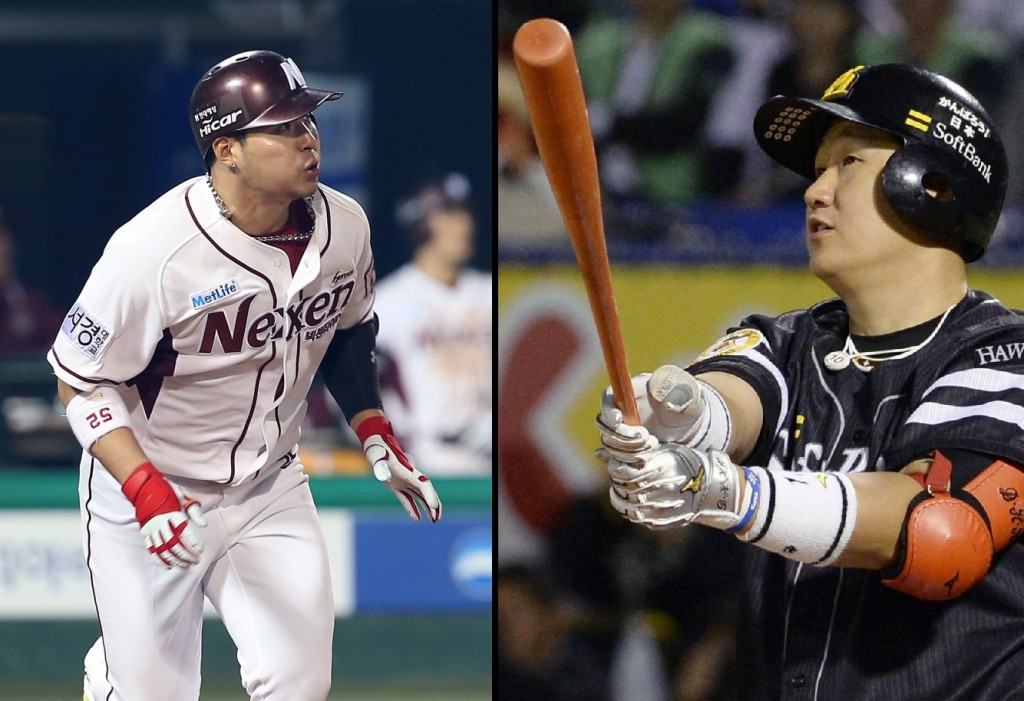- California Assembly OKs highest minimum wage in nation
- S. Korea unveils first graphic cigarette warnings
- US joins with South Korea, Japan in bid to deter North Korea
- LPGA golfer Chun In-gee finally back in action
- S. Korea won’t be top seed in final World Cup qualification round
- US men’s soccer misses 2nd straight Olympics
- US back on track in qualifying with 4-0 win over Guatemala
- High-intensity workout injuries spawn cottage industry
- CDC expands range of Zika mosquitoes into parts of Northeast
- Who knew? ‘The Walking Dead’ is helping families connect
Park Byung-ho or Lee Dae-ho: Which import should MLB teams choose?

South Korean baseball players Park Byung-ho, left, and Lee Dae-ho are hoping to strike a deal with Major League Baseball teams for a contract to play in the U.S. (Yonhap)
By Brian Han
Two exceptional South Korean baseball players are hoping to play for a Major League Baseball team next season. They are both first basemen. They both have extensive professional experience under their belt. They are both coming off of the best year in their careers.
So should Major League Baseball teams choose Park Byung-ho or Lee Dae-ho?
Starting with the 29-year-old Park, consider that he’s four years younger and coming off of back-to-back 50+ home run seasons.
The man plays like he’s straight out of a video game. The majors haven’t seen numbers like that since the turn of the century.
He’s a bit on the short side for a major league first baseman at 6-foot-1, but he makes up for it with a good glove that earned him several defensive awards.
His final stat line for the 2015 Korean Baseball Organization regular season included a jaw-dropping 53 homers, 146 RBIs (an all-time league record) with a .343 average.
Like we said, video game numbers.
Lee Dae-ho is a slightly different story. He’s taller at 6-foot-4, and built more like David “Big Papi” Ortiz.
He’s slightly more proven as he is coming from the Nippon Professional Baseball (NPB) league in Japan. He most recently led his team to a championship and earned series MVP honors. He had two home runs and eight RBIs with a .500 average (8-for-16).
The 33-year-old held his own during the regular season hitting .282 with 31 home runs and 98 RBIs.
The NPB has long been considered a higher level league than the KBO. South Korean players who have put together solid seasons in the KBO found lesser forms of success when moving off the mainland to Japan to more or less support that argument.
For example, first baseman Kim Tae-kyun excelled in the KBO. He regularly posted an average above .300 with some definite pop.
Once he joined a Japanese squad in 2010, his average fell to almost .250 and with less contact, came less home runs. To prove that he wasn’t just declining from age, the 33-year-old actually came back to the KBO and hit a career-high .365 in 2015. If anything it made him better.
Another infielder Lee Bum-ho who established himself as an offensively proficient third baseman saw his average drop to a paltry .226 during one season for the Fukuoka Softbank Hawks.
That’s the same team that Lee Dae-ho plays for now. So when he puts up those numbers in the NPB, it means more than the numbers that Park is putting up over in South Korea.
So given the differences in the leagues, the two aren’t really as far apart from each other as the numbers would suggest.
There has already been a lot more buzz around Park. One, because he mentioned his intentions much earlier on, two, the sheer absurdity of his stats and three, former teammate and Pittsburgh Pirates shortstop Kang Jung-ho.
Kang was the first position player ever to go from the KBO to the MLB. Not only that, he excelled during his first season that unceremoniously ended after a questionable slide by Chicago Cubs player Chris Coghlan.
Nonetheless, the South Korean played in 126 of 162 games and had 421 at-bats in which he hit .287 with 15 home runs and 87 RBIs. That’s better than anyone expected including the Pirates.
For a middle infielder to hit for power and establish himself as one of the best rookies in the league was more than they asked for. Now he looks like a bargain at $16 million over four years.
Then it’s understandable why as many as 12 major league teams have reportedly expressed interest and scouted Park in the past year.
Lee on the other hand wasn’t really on the radar as much as his KBO counterpart, but MLB scouts have long been aware of the disparity in talent between the two Asian leagues.
He even went out of his way to say that money is not an issue for him. He just wants some playing time in the bigs.
Low cost, success at a level closer to the MLB and a genuine desire to play ball with the best in the world? Those are pretty good pitches for any team looking for a slugger. The fact that Lee is a free agent and does not require posting fees may make him more enticing to Major League clubs.
However, one should not forget that the bar is much higher for first basemen. As a middle infielder, Kang would have been considered a success if his Korean numbers translated to 10 to 15 home runs in the U.S., but for Park and Lee, that would not nearly be enough to take up first base or designated hitter (DH) slot.
There’s almost more pressure on these two first basemen to prove that Kang wasn’t a fluke, so that South Korea can steadily produce talent worth buying in the states.
















Pingback: Ho | Equal Calories
Pingback: Park Byung-ho or Lee Dae-ho: Which Korean import should MLB teams choose? - Sports.Roxy-Publishing.com
Pingback: T Kang Taekwondo | self - self defense